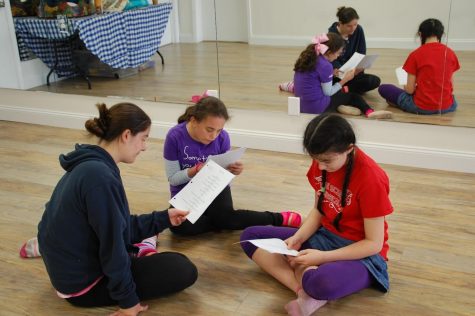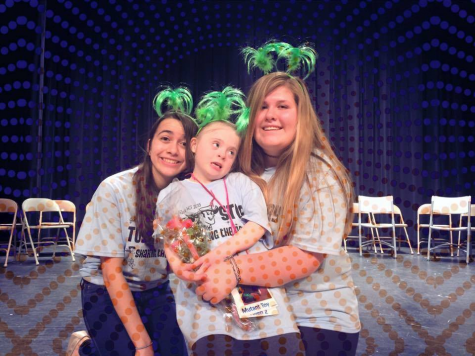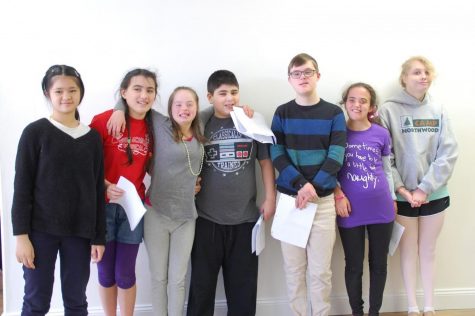Hooked on helping others
How one boy's passion for musical theater enabled him to help special needs kids, and watch them grow.
December 5, 2017
The Sound of Music
The Little Theater is a large room in the basement of Glen Rock Middle School. To the right is a long series of mirror panels that span most of the wall. On either end of the mirror there are small basement windows that let in very little light. The dance mat is longer than the mirror and just as wide as the room, but not quite as long. The white walls, scuffed by trim of the mat, never seem to be cleaned. The back right corner opens up to a cordoned off area, Joanne Brown’s office space.
Five years ago in that very room, Brown approached a pale, skinny, and blonde seventh grader with an offer. She asked him to help children with special needs through something she knew the boy had always loved: musical theatre.
Nick first discovered his passion for musical theatre in elementary school when he saw his sister Christina in the middle school’s production of Beauty and the Beast. For years he was in awe of how production can create a world apart from the one he knew. The lights, songs, costumes, and dramatic flair were what brought him into the inspiring culture of play production. His first role was when he was in 6th grade as Michael in Peter Pan, and from then on, Nick was hooked.
After Peter Pan, his theatre life came in a whirlwind of new roles and formative experiences. He was cast in the Bergen County Players show. The school year after that, he was in Oliver and soon after was when Brown invited him to help with the project.
One day, as the students filed out of the Little Theater, Brown pulled Nick aside. She informed him of the program she had been running for over five years and how it helped kids with developmental disorders learn about music and performing while practicing social and speaking skills.
“It’s called Sharing the Arts,” Brown said.“It’s at Orchard Elementary School every Saturday. I think you would enjoy it if you volunteer for a class or two.”
Nick’s first class hooked him the same way watching his sister in Beauty and the Beast had reeled him into its inviting environment . He loved the warm ups that the volunteers ran with the students, as well as the sense of accomplishment students personified when they ventured back to their seats after perfecting a script. Once he started participating, he couldn’t be stopped.

Anything Goes
After years of volunteering, Nick was finally put in charge of his own class. He saw this as an opportunity to set his class apart from others in the area by utilizing his unique perspective. As the location had changed from Ridgewood’s Orchard Elementary School, he needed to become used to his new job and environment at the same time.
Nick’s first room at 1 Gym 4 All was filled with colored swings, climbing ropes, and balance beams in varying patterns of the primary and secondary colors. This enticed students to the “off limits” area that took up the bulk of the room. The students tried their best to pay attention to the part of the room with a chalkboard wall and wood floors. Opposite the play area was another space, this one seemingly half of the size of the play area with a large chalkboard on the wall and several small plastic tables and chairs. Nick’s group stayed in the chalkboard area during class, but after class his students were free to roam the whole room.
Nick had spent four years watching teacher after teacher come and go from the program, and with most, the same issues resurfaced time and time again. Pop songs were a first choice for most and an easy genre to teach, but checking for hidden innuendos in every song became tedious and sometimes less effective than anyone could anticipate. More importantly, Nick’s objective had always been to spur personal growth and development through what he taught. He had found singing revised versions of pop songs that his students already knew gave them very little incentive to grow.
With his own class, Nick was free to find his own solution to the issue of pop songs in what he knew and loved best: musical theatre. Utilizing a love for musical theatre and Broadway musicals provide a positive learning experience in the correct was an idea insisted by another high school student, Cara, who Nick had previously learned a lot from.
Nick’s ultimate goal had always been to use Sharing the Arts as a way to help his students’ lives long term. To Nick, the exercises they did in class were a catalyst for the life skills they would learn. Sure, a scene was good fun, but the true incentive was to teach teamwork, interpersonal communication skills, and ways to convey and interpret emotion. If there was a group song, it was to improve memory, confidence and sense of time. The purpose, he decided, was no longer to have the best presentation possible, but to develop imperative skills that many of his students lacked.
As the students gradually compiled new life skills from the class, he felt more and more rewarded. It was an enjoyable time for students to express themselves without any judgment and for Nick to work on personal skills with them without the guidance of parents. It helped the students to have experience independence each day, and in Nick’s class that was finally compensated.

Fears in class
Many of his students over the years needed specific accommodations to be made for them, be it a small issue of behavior that changed the way they would be handled in class, or alterations that changed the atmosphere of the class for everyone. Sometimes, as Nick learned, there were accommodations that were impossible to make in time.
Nick shifts in his seat. “Unfortunately, a lot of times you find out one of the students has a trigger by setting it off,” he says.
For the last practice of Nick’s first solo class, he announced that he would be decorating their space in 1 Gym 4 All. What he did not know, though, was that one of his students suffered from very serious Globophobia, the fear of balloons. As the student entered class that day, he began shaking at the sight of the balloons Nick and his volunteers had inflated. He broke down, and Nick had to immediately remove the balloons from the room.
The “Balloon Thing” is only one reminder of just how self aware Nick and his volunteers have to be every time they enter the classroom. With eight or more students in a room, all with different needs and personalities, there are a number of things that can go awry. Though most days are uneventful and calm, there have been several instances of tense conflict between students during classes.
One day, Nick sneezed.
It seemed harmless enough, everyone sneezes. He was getting over a cold and there was a bug going around his school. Nonetheless, he apologised, explained his cold and continued class. One student reacted in a way that he would never have expected from a seemingly meaningless sneeze. Out of fear, she tried to leave the classroom. Nick found that she would react less severely if she didn’t think the sneeze was contagious, such as if the person were on antibiotics or only suffering from allergies.
Despite the difficulties, Nick will be the first to assure you that managing these triggers is just one part of a very large and rewarding job. They now keep balloons out of the room, and Nick keeps contagions as far from the girl with germophobia as possible.

Getting to know you
Connor Carson is a 15 year old and new to Nick’s class. He is the comparatively tall, blonde, and quiet boy. He, like everyone else in that class, has a life story riddled with struggles. Connor’s mother, like so many mothers of Down Syndrome, has been trying to make the typical 15 year old life possible for him since he was in utero. Being a mother of a child with Down Syndrome means that you need to think through every activity and every minute. Typical parents worry about their children, but for a parent of a child with Down Syndrome…it is heightened to an extreme.
“‘Did I give him a knife and fork?’ ‘Are they the right size?’ ‘Is the knife too sharp?’ ‘Is the knife too dull?’ ‘How long should I let him struggle with that before I cut it for him?’ You’re constantly thinking about these things” said Linda Carson, Connor’s mom.
Connor was born with cataracts and two holes in his heart.
Today, Connor is legally blind, but he has come miles from where he once was. Connor has always suffered from nystagmus, a condition that makes his eyes jiggle in their sockets and move naturally to the left and down. When he tried to focus on anything, he had to look straight at it. This meant that his head had to be all the way back and to the right in order to see something right in front of him, and even then, his astigmatism only allowed for eight inches of sight. For years he lived his life at that angle, not able to see from any other, until he underwent two cosmetic surgeries to tie the muscles that hold up his eyes where his “null point”, the point at which he can see best, was straight forward. While the shaking aspect of his nystagmus can only be grown out of, his null point was finally centered.
From a very young age, Connor had a series of issues with his adenoids. The adenoid is the tissue above the sinuses in the nasal cavity. It disappears by adulthood, but in children, it manages the drainage of fluids from the nose and ears and, if infected or enlarged, can cut off the ability to breathe through the nose. For Connor, this meant that his nose would drain all day, he would have trouble breathing, he would get croup five times every year, and he suffered a series of ear infections through the drainage tubes connecting the adenoids and ears. He never lost his hearing entirely, but he did lose his startle reflex for a time, meaning that if a dog barked behind him, he would have no reaction at all. These issues turned into four ear surgeries and an adenoid surgery. Finally, he was able to breathe. His nose stopped running, and he had far fewer issues with his health.
Connor’s medical history is extensive, like most of his peers, but it says nothing about who he is. Connor likes to sing. Connor likes to sing like a fish likes water. When he wakes up in the morning, he sings and dances around the house getting ready for school. In the car ride there, he sings along with the radio the whole way. Even when he was nonverbal early in life, he was always listening to music. Now, as he learns sign language in school, he signs with his songs.
He started Sharing the Arts in Ridgewood in 2012 with their production of the Seussical. The Carsons quickly saw the inclusive nature of Sharing the Arts in Ridgewood. In his first show, there was a nonverbal boy with recordings of his lines on an Ipad that he played without speaking. There are many programs for special needs children, but few that have integration of differently abled children and their normally abled peers, and far fewer are centered around the performing arts.
Connor is also involved in the Challenger League, one of the peer oriented programs that help differently abled kids and teens. They play baseball, soccer, basketball and track together, providing a fun, low-pressure environment that is irregular in sports.
Ridgewood was a great starting point for him, but it was far from his home in Demorest, and was always on weekdays. When Linda saw the link for Nick’s Saturday class in Waldwick, she jumped on it. “I like it, it’s more individualized,” Linda said. With the smaller class, Nick chooses the less daunting task of a series of short scenes and group songs, whereas Ridgewood puts on an entire play. The loss of continuity is well made up by the warmups and individual attention every song, scene, and student gets.
What Connor really loves is creating connections between people. When he speaks to people that have an understanding of how to communicate with him, people who take an interest in who he is or who smile when they hear him sing, he lights up. People often, though, are wary of talking to him because they are unsure of how to handle themselves. The vast majority of people with Down Syndrome can hold a conversation, all it takes it to be interested in what they have to say.
